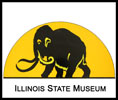Bison
Bison, Bison bison
Bison were keystone herbivores on the grasslands of North America. The iconic image of vast bison herds spread across the Great Plains characterizes the historic period in the Midwest, but in the not-so-distant past, bison were distributed throughout North America and utilized many different ecological niches.
Bison in Midwestern Tallgrass Prairie, Illinois State Museum.
Height: 1.7 m (bulls); 1.5 m (cows)
Weight: 500-900 kg (bulls); 300-500 kg (cows); Meagher 1986
Physical Description:
North American Bison are the largest living members of the family Bovidae. Head and forequarters are massive, accompanied by a pronounced "hump" above the shoulders. This hump is made up of muscles from the head attaching to the dorsal spines of vertebrae. Both males and females have robust, upwardly-curving, horns. Modern bison horns have a spread of 50-80 cm, although they could be much larger in the past. Shoulder height is accentuated by the pronounced hump. Adults are sexually dimorphic, with males approximately 10% larger than females of the same age. Traditionally, two sub-species of bison have been defined on the base of body morphology and pelage characteristics: Bison bison bison (Plains Bison) and Bison bison athabascae. Recognition of genetic and phenotypic variability in bison across their range in recent years suggests these differences are due more to biogeography than isolated breeding populations. This pattern seems to extend into the Holocene as there are no significant skeletal differences between late Holocene bison populations, whether they occupied the relatively closed forests of the Ohio River valley (Big Bone Lick, KY) or the open-grasslands of the Northern Great Plains (Widga 2006).
Pelage characteristics are seasonally and geographically variable. Shaggy, dark, fur on the head and forequarters is common in the Northern Great Plains and Northern Canada, however, this coloration in southern bison is much less pronounced (Krumbiegel and Sehm 1989). The coat fills in during the cold season. As conditions warm in the spring, bison shed their winter growth, which can be very uneven.
Traditionally, bison were considered an obligate grazer of North American grasslands. Although true historically, recent research on bison outside of the Great Plains suggests these animals were relatively flexible large herbivores. Their presence in eastern forests, midwestern marshes, and arid parts of the Great Basin indicate bison were successful in a wide range of habitats.
In keeping with their generalized habitat preferences, bison utilized a variety of forage types. In the High Plains, bison subsisted on shortgrasses. In the eastern woodlands, bison were browsers of herbs and woody vegetation. Recent work on tooth wear patterns and the chemistry of bones and teeth indicate bison were opportunistic herbivores with a wide diet breadth. Generally, Midwestern bison teeth show wear patterns suggestive of browsing leaves and woody vegetation up until the historic period, when they switched to a diet dominated more by grasses and upland forage.
Bison are gregarious animals and historically congregated in large herds. Two general types of herds are present. The first is dominated by cows and calves, with the occasional adult male. The size of these herds varies seasonally; larger cow-calf herds are present in the spring and summer. Smaller bull herds are also present throughout the year. Membership in bull groups is very fluid. Bison herds exhibit a social hierarchy. During the rut in the fall, dominant bulls are more successful breeders. Historically, there is some evidence for seasonal migrations in bison, although it is also clear that some populations did not migrate. Stable isotope studies of middle Holocene bison in the eastern Plains suggest that bison did not engage in seasonal migrations (Widga et al. 2010).
Bison are not common in Midwestern deposits during the Ice Age. During the subsequent Holocene, these animals become more common, and are preserved along the Ohio River (Widga 2006) and in the peat and marl deposits of northwestern Illinois and western Wisconsin (McMillan 2006).
At the end of the last Ice Age, bison populations expanded significantly. During the early Holocene, large herds are present in the Great Plains where they were an important subsistence resource for human groups.
Berger, J., & Cunningham, C. (1994). Bison: mating and conservation in small populations. Columbia University Press.
Krumbiegel, I., & Sehm, G. G. (1989). The geographic variability of the Plains Bison. A reconstruction using the earliest European illustrations of both subspecies*. Archives of Natural History, 16(2), 169-190.
McDonald, J. N. (1981). North American bison: their classification and evolution. Berkeley: University of California Press.
McHugh, T. (1972). The Time of the Buffalo. University of Nebraska Press.
McMillan, R. B. (2006). Records of Early Bison in Illinois. Illinois State Museum Scientific Papers, 31.
Meagher, M. (1986). Bison bison. Mammalian Species, (266), 1-8.
Widga, C. (2006). Niche variability in late Holocene bison: a perspective from Big Bone Lick, KY. Journal of archaeological science, 33(9), 1237-1255.
Related Animals:

